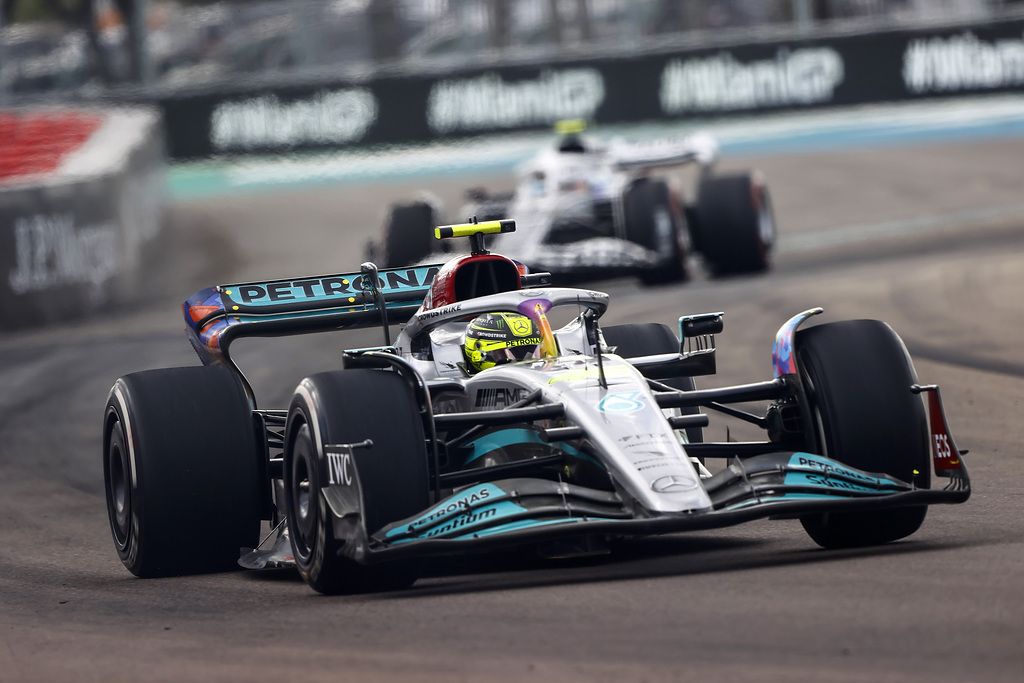Mercedes technical director Mike Elliott has defended Lewis Hamilton’s Miami race strategy which he says caught the team “between a rock and a hard place”.
Hamilton ultimately crossed the finish line in P6, behind new Mercedes teammate George Russell once again, after losing out in an intense intra-team battle with Russell and being disadvantaged by the timing of the safety car.
The crash between McLaren’s Lando Norris and AlphaTauri’s Pierre Gasly brought out a full safety car on Lap 41 in Miami GP. It lent a huge helping hand to Russell, who’d started on the longer-lasting hard tyres and hadn’t pitted when the safety car was deployed, enabling him to gain time whilst pitting at almost exactly the right time for him.
Meanwhile, Hamilton had already made his one and only stop of the race on Lap 22, switching from his race starting mediums onto hard tyres. After a few moments of debate and confusion in the Mercedes pit garage between the mechanics and the pit wall, he himself was asked about whether to pit, and responded with the affirmation that ‘it’s not my job’.
Elliott spoke in depth in response to a question from a fan on what exactly happened around Hamilton’s pit stop discussions, on the Miami edition of the team’s debrief video. “The VSC came first, and we pitted George, exactly the right thing to do,” he said. “We were then in this position where we would have had quite a big gap between Valtteri, closely followed by Lewis with George a chunk behind and at that stage of the race with both Valtteri and Lewis on the hard tyre, Lewis was closing into the back of Valtteri and was going to have a chance to overtake on track for a normal racing pass and that’s what we expected the race to sort of pan out.
“But that virtual safety car very quickly turned into a full safety car and at that point it was close all the gaps up, compress the field back up and we were going to be in a position where George was on a brand-new medium against an ageing Hard tyre on Lewis and an ageing hard tyre on Valtteri. So, we were caught between a rock and a hard place.
“The safety car came at the completely wrong time for Lewis. If we didn’t pit him he was always going to have George behind him on a much newer tyre, if we did pit him, he would lose track position to George, he would end up behind George on track,” summed up Mercedes technical director.
The position of Hamilton on circuit ultimately was the key decider in electing to keep him out on track, with the certain risk of losing track position at a circuit which had already proved tough to overtake around throughout the weekend, with Elliott predicting the soft tyre’s characteristics as another potential hindrance.
“Although Lewis would have had a new tyre, the only new tyres we had available to us was the hard or the soft and while you might think the soft would have been a good solution, we knew that the soft tyre would overheat very quickly,” said Elliott. “We knew [the soft tyre] would overheat even more quickly because he was just behind George fighting on track and that would have put even more heat into the tyres.
“So, we were in that position where we were sort of caught between a rock and a hard place and there was no real right answer,” summed up Elliott. Switching his attention to the radio dialogue broadcast between chief strategist James Vowles and Hamilton, Elliott details how everyone was unsure what to do at the time.
“If you were watching the TV, you would have seen us asking Lewis that question, what did he think he wanted to do?,” he said. “That was just because there was no right or wrong answer and sometimes the drivers have a better feel in the car than we as the engineers do looking at the data. So as it happened it was just the circumstances that took place meant Lewis lost out because of the safety car.”
Even though it’s a rare thing for the pit wall to override their own thoughts on a strategy and directly turn to the driver for help, it is not unheard of in modern Formula 1, especially as a drivers’ feeling on a certain set of tyres is so unique and unpredictable on high degradation Pirelli rubber. And Elliott sums up the situation as an “unlucky” one for Hamilton which he hopes “balances up” over the course of the year.
“Unfortunately Lewis had been unlucky a couple of times already this season but it is just the way that things pan out and hopefully over the season it balances up and he will have some advantages that come to him through the timings of the safety cars in future races,” he said.
He was also asked about the battle between the pairing, and specifically why Russell gave back the position to Hamilton when he’d completed part of an overtake off of the circuit at Turn 11. “The simple answer is that in the eyes of the stewards, George had gained a lasting advantage by passing Lewis off the track and therefore we were asked to swap the cars back over and that’s what we duly did,” stated the Mercedes chief.
Here’s Lewis Hamilton, George Russell on frustrating battle



















